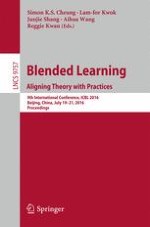2016 | OriginalPaper | Buchkapitel
Virtual Reality Enabled Training for Social Adaptation in Inclusive Education Settings for School-Aged Children with Autism Spectrum Disorder (ASD)
verfasst von : Horace H. S. Ip, Simpson W. L. Wong, Dorothy F. Y. Chan, Julia Byrne, Chen Li, Vanessa S. N. Yuan, Kate S. Y. Lau, Joe Y. W. Wong
Erschienen in: Blended Learning: Aligning Theory with Practices
Aktivieren Sie unsere intelligente Suche, um passende Fachinhalte oder Patente zu finden.
Wählen Sie Textabschnitte aus um mit Künstlicher Intelligenz passenden Patente zu finden. powered by
Markieren Sie Textabschnitte, um KI-gestützt weitere passende Inhalte zu finden. powered by
